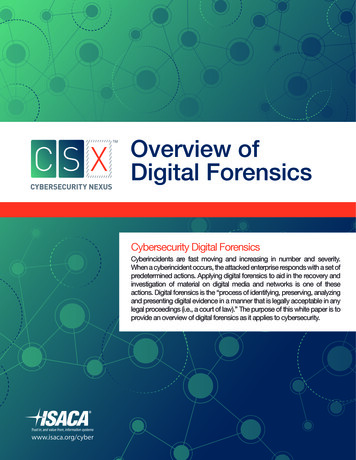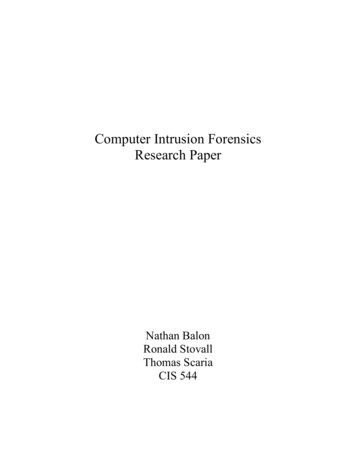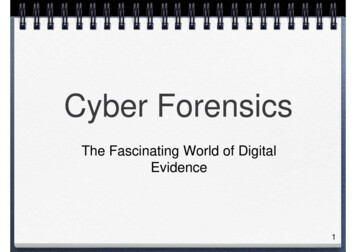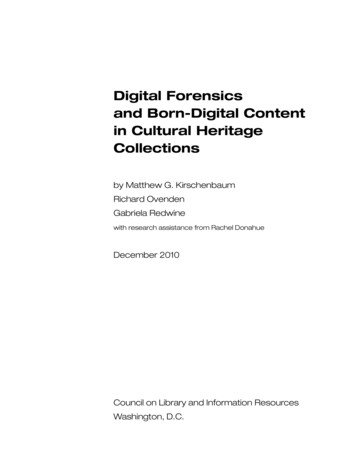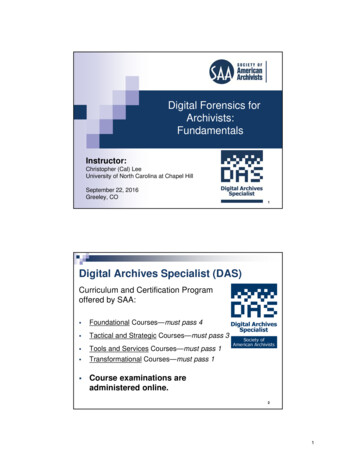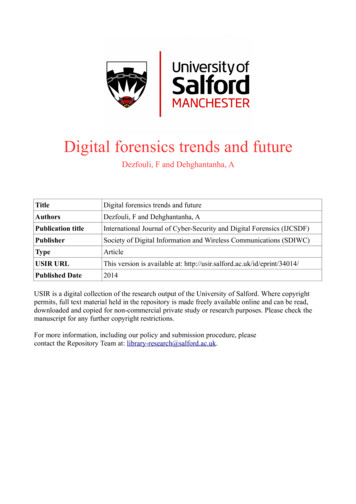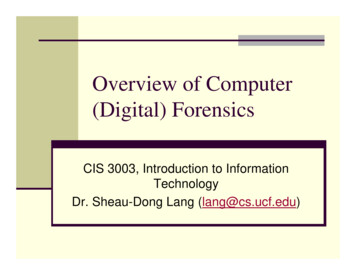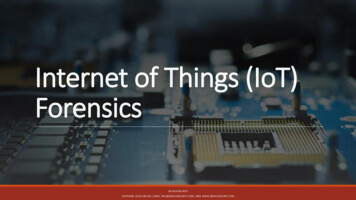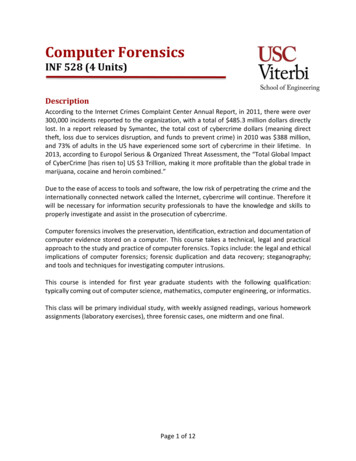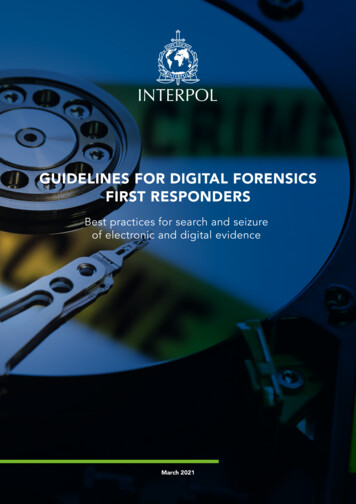
Transcription
GUIDELINES FOR DIGITAL FORENSICSFIRST RESPONDERSBest practices for search and seizureof electronic and digital evidenceMarch 2021
1010101 10101010101010101 01010101010101 01010101010101 01010101010101 201010101010101 01010101010101 01010101010101 01010101010101 0101010101010101 01010101010101 01010101010101 01010101010101 01010101010101 01010DisclaimerThese “Guidelines for Digital Forensics First Responders” (the “Guidelines”) have been prepared astechnical guidelines to provide information and advice on digital forensic approaches that may beadopted when seizing and analysing different kinds of devices. These Guidelines are solely for the useof law enforcement professionals having the necessary legal basis or authorisation to perform theactions described herein.The legal, procedural and customary frameworks in respect of search, seizure, chain of custody,analysis, reporting, submission in criminal/prosecution/judicial process, evidentiary evaluation,admissibility and probative value, etc., differ widely by jurisdiction. These Guidelines do not provideany recommendations, advice or instructions in respect of requirements under such legal andprocedural frameworks in any jurisdiction and any references seemingly suggesting as such should beread as being subject to domestic laws and procedures in this regard.Readers are advised to ensure, when taking any actions based on these Guidelines, to verify and besatisfied that such actions are in compliance with appropriate legal and procedural requirements orstandards in their jurisdictions.These Guidelines are not mandatory in nature and have no enforceability. INTERPOL shall not be liablefor any actions taken by any parties based on these Guidelines which are contrary to or inconsistentwith or not in compliance with any relevant legal, regulatory, administrative, procedural, evidentiary,customary, or other requirements, exhibit extraction processes, chain of custody records to bemaintained, etc.These Guidelines also include mentions of open source, proprietary and publicly available tools andservices (collectively, the “Tools” and each, a “Tool”) that offer various functionalities. They may beviewed, downloaded and/or used at the discretion of the user. In relation to these, please note thefollowing: INTERPOL has not developed or verified the Tools, does not endorse them, has no associationwith their providers, and does not license or provide any support for the use of such Tools.INTERPOL provides no warranties (express or implied) in relation to the Tools or any of them,their utility for any purpose or effectiveness. Links to other websites from these Guidelines do not constitute an endorsement by INTERPOL,and are only provided as a convenience. It is the responsibility of the user to evaluate thecontent and usefulness of information obtained from other websites/ using these Tools. INTERPOL does not control, monitor or guarantee the contents of the links or the Toolsprovided herein, or their data collection practices; it does not endorse any views expressed orproducts or services offered therein.
01010101010101 01010101010101 01010101010101 01010101010101 010101010130101 01010101010101 01010101010101 01010101010101 01010101010101 0101010101010101 01010101010101 01010101010101 01010101010101 01010101010101 It may be necessary to create user accounts, pay subscription or one-time fees or upgradationfees in order to use some of these Tools. Registration or creation of user accounts, paymentof fees or charges may require authorisation from your organisation and be subject to legalrequirements in your jurisdiction (including for the creation of fake or assumed identities forthis purpose). Please ensure that you have the requisite authorisations to use the Tools.INTERPOL does not encourage or in any manner, authorise doing so, and will not be liable inrespect of any actions you take to create accounts or registrations, pay any fees orsubscriptions, or if you assume any identities or create fake credentials, in order to use anyTool. Each of these Tools may be subject to licenses, privacy policies and to the terms containedtherein. Please review carefully any such terms, conditions or privacy policies that apply tothe use of any Tool you wish to use. Information entered into any of the Tools may be saved on the servers of the company thatprovides the Tool, and the legality of this within your jurisdiction must be tested and verifiedby you. It is also the responsibility of the user to test the data collection practices and privacypolicies of the Tools as against their national legal requirements. Any use of the Tools (or any of them) is at your own risk, and INTERPOL shall not be liable orresponsible under any circumstances for any damage or loss incurred, caused or alleged to becaused due to your use of or reliance upon any of these Tools. Any claims or actions in relationto any damage or loss incurred by a user should be directed to the providers of the Tool(s)and not INTERPOL. No data that is input in the use of any of these Tools will be transmitted to or be available toINTERPOL in any way. Should you choose to use any of the Tools for forensic, analytical orinvestigative purposes, you acknowledge that INTERPOL shall not receive any information inthis regard, and at no point will be in the chain of custody of any evidence analyzed orgenerated using any such Tool.
1010101 10101010101010101 01010101010101 01010101010101 01010101010101 401010101010101 01010101010101 01010101010101 01010101010101 0101010101010101 01010101010101 01010101010101 01010101010101 01010101010101 01010AcknowledgementsThe Guidelines are based on the Electronic Evidence Guide of the Council of Europe, on the DigitalEvidence Collection Certificate Manual of the National Center of Excellence in Cybersecurity in Spain(INCIBE), and other best practice guides of law enforcement agencies concerning the seizure andtreatment of electronic evidence. The INTERPOL Innovation Centre Digital Forensics Laboratory (ICDFL) also received feedback from digital forensic experts from different parts of the world, to meet aconsensus for some of the debated or troublesome aspects encountered by digital forensic firstresponders. We wish to mention and thank the following colleagues below, whose valuable input hashelped to improve the agencies worldwide: BRAZIL: National Institute of Criminalistics Brazilian Federal Police;SPAIN: Cybercrime Unit, General Commissary of Criminal Police (CGPJ) of Spanish NationalPolice (CNP);The Scientific Working Group on Digital Evidence (SWGDE)INTERPOL would also like to express its sincere gratitude to the Norwegian Ministry of Foreign Affairsfor their support and contribution in the creation of the Guidelines.The Guidelines will be referenced during an online training activity (Nov-Dec 2020), conducted in theframework of INTERPOL Project LEADER; a three-year capacity building initiative funded by theNorwegian Ministry of Foreign Affairs. The project focuses on enhancing digital forensics capacities ofbeneficiaries’ in the South and Southeast Asia region. Through such endeavours, key stakeholders’ ofthe project including digital forensic first responders and their law enforcement institutions will havethe opportunity to strengthen their knowledge on the best practices articulated herein. Moreover,the guidelines will also serve the purpose as an invaluable reference tool across all INTERPOL membercountries ensuring that advice on the handling, collecting and preservation of digital evidence tosupport investigations, are available to those law enforcement officers involved in such procedures.
01010101010101 01010101010101 01010101010101 01010101010101 010101010150101 01010101010101 01010101010101 01010101010101 01010101010101 0101010101010101 01010101010101 01010101010101 01010101010101 01010101010101 ForewordIn pursuit of providing guidance and support to law enforcement agencies across the globe, theINTERPOL Innovation Centre (IC) developed the INTERPOL Guidelines for Digital Forensics FirstResponders: Best Practices for Search and Seizure of Electronic and Digital Evidence. I am pleased topresent these Guidelines which aim to establish best practices for handling and using digital evidenceduring search and seizure preparatory and execution stages. Key technical considerations are alsoidentified on the effective preservation of data to ensure that it can support law enforcement incriminal investigations and it can be admissible in court. This guide is intended to assist lawenforcement officers from different crime areas who may attend to a crime scene, being responsiblefor collecting, securing, and transporting electronic and digital evidence. It will also be helpful forsupervisors of aforementioned officers in guiding and supporting them. Moreover, it can be useful forprosecutors to get a better understanding of collection and handling of evidence.As our society becomes increasingly integrated with digital technology encompassing every facet ofour daily lives and law enforcement work, it may be difficult to remember an occasion where you hadlimited interaction with a digital device. For today’s law enforcement community, there is acontinuous trend towards investigations relying on some form of digital evidence. While we wouldconsider that digital evidence indeed shares similar aspects when compared to traditional forms ofevidence, there are also unique considerations to be taken into account.The intangible nature of data obtained in electronic form, its volatility, and the ease at which it can bealtered, all pose challenges to the integrity of digital evidence. Thus, it is vital that first responders andlaw enforcement practitioners are able to properly identify and handle digital evidence ensuring thatthe latter stages of the digital forensic process can be performed on the basis of sound judgement.I am grateful for the contribution of the IC team, particularly its Digital Forensics Laboratory (DFL) forsharing their knowledge and subject matter expertise. I also extend my thanks to our colleagues fromthe INTERPOL Capacity Building and Training Directorate (CBT) who have supported this initiative andwill utilize the Guidelines in the context of projects focused on enhancing digital forensic capabilities.Finally, I would like to thank the Norwegian Ministry of Foreign Affairs for its generous support.The Guidelines are a reflection of INTERPOL’s sustained efforts in fostering international policecooperation and our commitment to assist our member countries in response to the complex globalsecurity challenges in the digital domain.Director Anita HazenbergINTERPOL Innovation Centre Directorate
1010101 10101010101010101 01010101010101 01010101010101 01010101010101 601010101010101 01010101010101 01010101010101 01010101010101 0101010101010101 01010101010101 01010101010101 01010101010101 01010101010101 01010ContentsList of figures91. INTRODUCTION102. SEARCH AND SEIZURE PREPARATION PHASE102.1. Planning102.3. Equipment preparation133. SEARCH AND SEIZURE EXECUTION PHASE153.1. Secure the scene153.2. Assessment153.3. Document the scene163.4. Collection and the handling of digital evidence173.4.1. Live analysis of powered computers and laptops173.4.2. Inability to access information on powered devices193.5. Seizure Phase203.5.1 Packaging and Transport204. TECHNICAL CONSIDERATIONS204.1. The forensic copy204.2. Alternatives to the forensic copy214.3. HASH function225. SPECIFIC PROCEDURES235.1. Smartphones - Tablets235.1.1. Considerations when securing mobile phone evidence245.1.2. Mobile Phone Evidence Preservation Process for First Responders255.1.3 iOS Preservation Process and Flowchart255.1.4 Android Preservation Process and Flowchart265.1.5 SIM Card285.1.6 Removable Media Card285.1.7 Cloud Data295.1.8 Considerations upon Seizure29Traditional Forensics29Access29Network Isolation29Points to Prove305.2. Servers315.3. Personal Computers315.4. Laptops34
01010101010101 01010101010101 01010101010101 01010101010101 010101010170101 01010101010101 01010101010101 01010101010101 01010101010101 0101010101010101 01010101010101 01010101010101 01010101010101 01010101010101 5.5. Storage media (memory cards, flash drives, external hard drives, optical discs, etc.)345.6. Other devices (Digital cameras, GPS navigation systems, Dash Cameras, etc.)365.7. IoT devices365.7.1. Smartwatches375.7.2. Smart TV375.7.3. Home kits/Smart speakers385.7.4. IP and concealed cameras395.8. Gaming consoles405.9. Drones415.10. CCTV435.11. Virtual assets devices445.12 Automotive Vehicles495.13 Shipborne Equipment51REFERENCES53
1010101 10101010101010101 01010101010101 01010101010101 01010101010101 801010101010101 01010101010101 01010101010101 01010101010101 0101010101010101 01010101010101 01010101010101 01010101010101 01010101010101 01010Acronyms, abbreviations, and ITNVMeOSP2P / SINTERPOL Capacity Building and TrainingClose Circuit TelevisionGeneral Council of the Judiciary – s the constitutional body thatgoverns all the Judiciary of SpainThe National Police Corps / Cuerpo Nacional de Policía - nationalcivilian police force of SpainCellular Network Isolation CardSubscriber Identity ModuleComma-separated values file formatDigital Forensics LaboratoryDeoxyribonucleic acidDigital Rights ManagementDigital Selective CallingElectronic Chart Display and Information SystemElectronic Control UnitsEmergency Positioning Indicator Radio BeaconGigabytesGlobal Maritime Distress and Safety SystemGlobal Positioning SystemGunshot residueHard driveHard disk driveINTERPOL Innovation CentreIntegrated circuit cardInternational Mobile Equipment IdentityInstituto Nacional de Ciberseguridad / The Spanish NationalCybersecurity InstituteInternet ProtocolLong Range Tracking and Identification SystemNon-Volatile Memory ExpressOperating Systempoint-to-point & point-to-multipoint (P2MP)Personal Identification NumberPersonal unlocking keys – sometimes known as a network unlockingcode (NUC) or personal unlocking code (PUC)Random Access MemoryRedundant Array of Inexpensive DisksRadio FrequencyRemotely Piloted Aircraft SystemRemovable User Identity ModuleShort Message ServiceSolid-State DriveSmall Unmanned Aerial SystemTerabyteTrusted Platform Module chipsUnmanned Aerial VehicleUnmanned Aerial SystemUninterruptible Power Supply System
01010101010101 01010101010101 01010101010101 01010101010101 010101010190101 01010101010101 01010101010101 01010101010101 01010101010101 0101010101010101 01010101010101 01010101010101 01010101010101 01010101010101 USBUSIMVHFVMSVINWIFUniversal Serial BusUniversal Subscriber Identity Module – a SIM card for 3G servicesVery High Frequency RadioVessel Monitoring SystemVehicle Identification NumberWallet Import FormatList of figuresFigure 1: Flowchart showing the procedure and planning phase . 12Figure 2: Devices: Smart phones and tablets. 23Figure 3: An Apple iPhone. 25Figure 4: Flowchart for Apple iOS device evidence acquisition procedure . 26Figure 5: Android smartphones . 27Figure 6: Flowchart for Android device evidence acquisition procedure . 27Figure 7: SIM cards. . 28Figure 8: SD Cards. . 28Figure 9: Components of cloud storage. . 29Figure 10: Digital cameras. 36Figure 11: Smart watches . 37Figure 12: A Smart TV. . 37Figure 13: Devices such as Amazon's Echo, Apple's HomePod are examples of Smart Speakers. . 38Figure 14: Internet Protocol Cameras send image data over an IP network. 39Figure 15: Nintendo, Sony's PS Series, and Microsoft's XBOX are examples of gaming consoles withsmart functions. . 40Figure 16: Drones, also known as UAVs (Unmanned Aerial Vehicles) . 41Figure 17: CCTV Cameras being used for surveillance purposes. . 43Figure 18: Virtual asset devices, used for storing information about cryptocurrencies and othervirtual currencies. . 44Figure 19: Paper wallets. 45Figure 20: Hardware wallets, used to store information about crypto assets. . 46Figure 21: Example of a desktop wallet. . 46Figure 22: Electrum, a desktop wallet . 47Figure 23: Example of a mobile wallet used for storing cryptocurrency information. . 47Figure 24: Brain wallets (seed) . 48Figure 25: Brain wallets (seed) . 48Figure 26: Examples of Shipborne equipment with data and their location . 52
1010101 10101010101010101 01010101010101 01010101010101 01010101010101 1001010101010101 01010101010101 01010101010101 01010101010101 0101010101010101 01010101010101 01010101010101 01010101010101 01010101010101 01010SEARCH AND SEIZURE OF DIGITAL EVIDENCE1. INTRODUCTIONThis guide aims to offer support and advice to Digital Forensic practitioners from law enforcementduring the activities of search and seizure for identification and handling of electronic evidencethrough methods that guarantee their integrity.An electronic device should not be seized without due preconditions. It is the investigation teamtogether with the digital forensic experts that will assist in the collection and processing of electronicevidence, who will determine whether it is relevant or not to obtain and process those electronicdevices.Electronic evidence, like all other traditional evidence, must be carefully manipulated so that they canbe incorporated as evidence in the judicial process. This affects both the physical integrity of thedevices and the information or data contained therein. It must be taken into consideration that someelectronic devices require specific procedures for collecting, packing and transporting, either becausethey are susceptible to damage by electromagnetic fields or because they may suffer changes in theircontents during handling and preservation.It should be taken in consideration that the possibility of obtaining traditional (non-electronic)evidence from the investigated scenario should not be excluded and that it could be relevant both forthe investigation and for the subsequent treatment of electronic evidence. This is the case of anyannotation related to the use of passwords, settings, email accounts, etc. These pieces of evidencemust be manipulated according to the established procedures to preserve and assure their probativevalue.2. SEARCH AND SEIZURE PREPARATION PHASE2.1. PlanningDigital data is a fundamental pillar for most law enforcement investigations today. With the advent ofthe smartphone, social media and internet personalization with services like Google and Apple, aperson leaves a digital trail and it is important that the digital trail is captured and analyzed forintelligence and evidence relating to the crime. The search and seizure phase is critical as this willsafeguard the devices and the data held on them. If digital equipment is seized and not handledcorrectly, there will be potential for the data to be lost through deletion by the user, remote wipingor manipulation by a third party.Suppose a team of police officers together with one or more digital forensic expert(s) have to fulfillthe order of a prosecutor to enter inside the house of an alleged criminal suspected of a serious crimesuch as murder or robbery. There is a possibility that the suspect, within their devices, such astelephones or computers, may hold files or documents that are decisive in resolving the case. Thesedevices must therefore be searched and, if deemed suitable for the investigation, seized.
01010101010101 01010101010101 01010101010101 01010101010101 0101010101110101 01010101010101 01010101010101 01010101010101 01010101010101 0101010101010101 01010101010101 01010101010101 01010101010101 01010101010101 In such cases, before starting any search and seizure activity, a series of considerations must betaken into account: A preparatory meeting should be held in order to exchange information between the unit in chargeof the investigation and the personnel of other specialties that go on a support mission. The intervention on the scene of these specialized units should be prioritized and coordinated, whichwill depend on the specific case under investigation. For example, priority may be given to the actionof Canine Units for the detection of explosives or DNA sampling collection prior to any other activity.It is necessary that the unit carrying out the investigation provides in advance certain informationneeded for the coordination of the various specialists who may participate in the search and seizure.In the preparatory meeting regarding the appropriate treatment of electronic evidence, participantsshould assess all the basic information of the case, the details about the search warrant regardingelectronic evidence or advice on the appropriate terms for the request of the warrant and, finally,specify the final destination of the seized goods.From the point of view of the collection of digital evidence, it is essential to carefully prepare and planall of the activities that will be carried out, taking into account a series of considerations such as: Nature of crime under investigation. The nature of the crime will determine the forecast of thenecessary equipment and the preparation of the most appropriate technical procedures for each case.For example, for crimes related to child sexual abuse, it is probably necessary to determine, in thesame act of search and seizure, the possession of this material, so it will be necessary to find evidenceor obtain the necessary samples (pictures, videos, chat sessions, etc.) “On-site” in an adequate andsafe way.In cases of financial crimes, it is very common to find infrastructure networks with user data stored incentralized or cloud servers, so it will be necessary to be clear about what type of electronicdocumentation is being sought, what is the best method to obtain it and where to store the datacaptured from those sources. Suspect’s Technical knowledge. Information about the suspects and their technical ability must becollected as they could have protected their equipment or data in some way that could compromisethe acquisition of the evidence. Encryption systems or automatic data deletion applications make itdifficult to obtain evidence. Location of data storage. It is not unusual for information to be stored in a place other than thephysical computer equipment of the suspect. Given this, it is necessary to verify the actual location inorder to require an additional legal authorization, especially if it is stored in a different jurisdiction, orif additional technical equipment is required to ensure the integrity of the evidence.All data that is needed to carry out specific actions in relation to the processing of electronic evidenceshould be specified in the search warrant application or relevant procedural requirement prior tosearch and seizure.In completing the procedural requirements, the final objectives of the action must be clear andspecifically, in regard to: The authorization for the seizureObtaining forensic images (“on-site” or not)Analysis of the devices “on-site”
1010101 10101010101010101 01010101010101 01010101010101 01010101010101 1201010101010101 01010101010101 01010101010101 01010101010101 0101010101010101 01010101010101 01010101010101 01010101010101 01010101010101 01010 Use of applications to obtain access passwordsAuthorization to change the password of email accounts or social networks, etc.Given the number of different case scenarios, we should consider the most appropriate actions to thespecific case. Although, and in most cases, it is advisable to use expressions that support without anydoubts the different actions to be performed. For example, “it is requested that the seizure, copyingand analysis of electronic devices capable of containing information in digital format will be done onsite.” The extent of precision and specificity that is required will depend on the jurisdiction and itslegal and procedural frameworks.2.2. The final destination of the evidenceFigure 1: Flowchart showing the procedure and planning phase
01010101010101 01010101010101 01010101010101 01010101010101 0101010101130101 01010101010101 01010101010101 01010101010101 01010101010101 0101010101010101 01010101010101 01010101010101 01010101010101 01010101010101 The destination of the seized items must be defined before starting any activity of search and seizure.Forensic copies, as well as devices that require specific treatment, should be sent to the correspondingdepartment/team for processing and analysis.For each case, adequate packaging, transport and documentation must be provided to maintain thechain of custody that begins during the seizure.2.3. Equipment preparationIt is advisable to have a checklist with the material to be carried to the destination so that one canverify that everything needed is available and in good condition. A template is provided below (to becustomized according to the procedural and legal requirements in the relevant jurisdiction).It is crucial to have enough devices where forensic images, clones or data from remote sources will bestored. These devices should preferably be brand new or, at least, securely wiped overwriting all ofthe data with a known sequence of characters, usually "00" in hexadecimal, to avoid any possible datacontamination.The following is a list that the officer must take into account consisting of the minimum forensic toolsneeded for a successful search and seizure activity:Forensic equipment⃝⃝⃝⃝⃝Laptop with the necessary standard forensic tools installedHardware write blockersForensic tools dongle licensesDongle 1Dongle 2Dongle 3Enough memory storage media (external HDDs) for images and remote data destinationHard Disk 1Hard Disk 2SD card 1HD with extra forensic software or bootable devicesTools to Disassemble⃝Screwdrivers (flat, star, hexagonal and other specific for certain models such as Hewlett Packard,Apple)
1010101 10101010101010101 01010101010101 01010101010101 01010101010101 1401010101010101 01010101010101 01010101010101 01010101010101 0101010101010101 01010101010101 01010101010101 01010101010101 01010101010101 01010⃝⃝⃝Pliers (standard and pointed)Clamps (for cutting cables)Small tweezersExhibit Documentation⃝⃝⃝⃝Photo or video camera (to take pictures of the scene and the screen content)Permanent markers (to encode and identify the investigated material)Labels (to mark and identify parts of the equipment, power supplies)Evidence tagsResources needed for packaging and transport/Consumables⃝⃝⃝⃝Evidence bags and sealEvidence carton boxes for media storage devices such as USB devices, DVDs, or CDs;Anti-static zip-lock evidence bagsFaraday Bags to inhibit signals to mobile phones and other devices that may receive data frommobile/Wi-Fi networkOther items⃝Small torch with stand
01010101010101 01010101010101 01010101010101 01010101010101 0101010101150101 01010101010101 01010101010101 01010101010101 01010101010101 0101010101010101 01010101010101 01010101010101 01010101010101 01010101010101 Gloves⃝Large rubber bands⃝Magnifying glasses⃝Network cables (crossed and braided)⃝Mask⃝3. SEARCH AND SEIZURE EXECUTION PHASEParticipant’s safety at the search and seizure is a priority issue. For this purpose, there are speciallytrained units. No one should enter the perimeter without having secured the area. People who are inthe scene will remain controlled at all times during the operations to avoid any alteration or datacompromise.The technical procedural steps described below are suggested, subject to applicable legal andprocedural requirements in the country.3.1. Secure the sceneIn the case of electronic evidence collection, the aim is to avoid the loss, alteration or destruction ofany possible evidence. For this, the following measures will be taken: Remove
These “Guidelines for Digital Forensics First Responders” (the “Guidelines”) have been prepared as technical guidelines to provide information and advice on digital forensic approaches that may be
